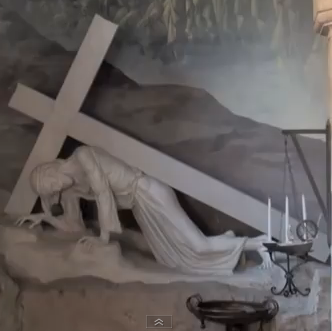Via Dolorosa: The Road of Grieving

In the Old City of Jerusalem lies a road that bears the name Via Dolorosa, Latin for the Way of Grieving. It is the path on which Jesus made his final journey carrying the cross from Pontius Pilate’s palace to Golgotha (also called Calvary) where he was put to death.
For as long as Christians have made pilgrimage to Jerusalem they have been walking the final path of Jesus. Jerusalem has witnessed for over 1000 years of the faithful as they come to experience Jesus’ last hours. Then as today, they view the sacred landmarks called the Stations of the Cross and find meaning in each step of this fateful path.
There are fourteen Stations of the Cross, each marking a significant incident in the crucifixion of Jesus:
Station 1: Jesus is condemned to death
Station 2: Jesus receives his cross
Station 3: Jesus falls for the first time
Station 4: Jesus meets his mother Mary
Station 5: Simon carries the cross
Station 6: Veronica wipes the face of Jesus
Station 7: Jesus falls for the second time
Station 8: Jesus speaks to the women of Jerusalem
Station 9: Jesus falls for the third time
Station 10: Jesus is stripped of his garments
Station 11: Jesus is nailed to the cross
Station 12: Jesus dies on the cross
Station 13: Jesus is removed from the cross
Station 14: Jesus is laid in the tomb.
The first eight stations are along Via Dolorosa itself and the last six stations are located in the Basilica of the Holy Sepulchre, the church built over Golgotha commissioned by Constantine in 325 CE. The route has been repaved, repaired and improved over time by the various factions that ruled Jerusalem.
However, in 1981 during an urban improvement project workers found what archeologists believe to be original paving stones from Via Dolorosa. These were cleaned and installed at Station 3 along the path as this the area they are believed to have originated. It is possible to imagine Jesus falling upon these very stones.
Pilgrims to Via Dolorosa will find the street can be noisy and crowded, which at first may seem to take away from this holy encounter. However, as vendors vie for visitors’ attention and residents push past busy with their lives, as the old Jerusalem stone buildings with stalls selling wares huddle close together along the path, one begins to realize that this was the same as when Jesus walked these seemingly endless stones.
At the time of Jesus this central pathway through Jerusalem would have been bustling with commerce. Furthermore, Jesus was tried and put to death during Passover when Jerusalem was at its busiest with people preparing for the holiday. The cacophony of voices, the crowds, the vendors’ stalls, all would have been experienced by Jesus as he made his way through the city and out to Golgotha.
As today’s pilgrims make their way from Praetorium through the Old City, they see in their mind’s eye Simon carrying the cross, Jesus meeting the noble woman, as him falling the first and second time. Then as they enter the Basilica of the Holy Sepulchre they will feel the fatigue and swelling sorrow as Jesus would leave the walls of Jerusalem struggling towards Golgotha and his destiny.
Thus ends the journey. Many visitors feel emotionally exhausted after such a journey, but they also feel brilliantly inspired. For here it came to an end, but it also began a new journey, one which changed the world.


